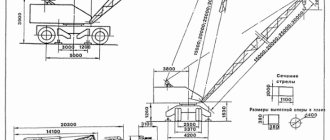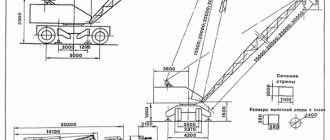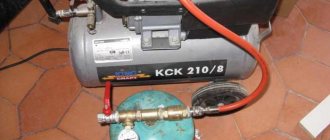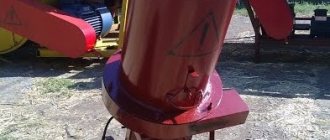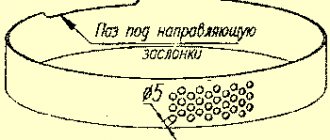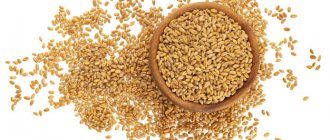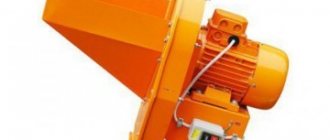Technical description of the feed chopper
The Bumblebee grain crusher is a universal device designed to meet market requirements. Based on reviews from numerous users, we can say that this is the best representative of feed cutters in its range.
The device easily copes with:
- Pine needles (pine meal is much richer in carotene than grass or alfalfa),
- Soft paper
- Any cereals,
- Wood chips,
- Birch bark,
- Straw,
- Mowed grass
- Senom,
- Stems and leaves of reeds.
Processed hay and straw are obtained into a very fine fraction, and are excellent for use in the preparation of animal feed.
The design features of the feed cutter allow it to work effectively even when foreign objects get into the drum. And to ensure that metal particles do not mix with the finished feed, a magnetic catcher is built into the lid of the working chamber. The grain crusher is equipped with special rollers that make it easier to move. The vacuum suction device allows you to pick up raw materials scattered on the floor.
Operational Features
The device is equipped with an 11-kilowatt engine that can rotate at speeds of up to three thousand revolutions per minute. In an hour of operation, the device is capable of producing from two to three tons of crushed grain: productivity depends on the density of the raw material and the speed of grain feeding into the drum. To operate, you must be connected to a 380 volt network.
The reliability of the device is largely due to the long service life of the rotor: two thousand tons of raw materials between maintenance. Hammers must be replaced every two hundred tons of the finished product. The weight of the device is 120 kg.
The basic package includes:
- Three-meter hose for suction of processed raw materials,
- Six bag stuffer
- Electrical ten-meter cable,
- Two replaceable sieves.
Design of the Shmel grain crusher
A very complex and very necessary design feature is the presence of a magnetic catcher, which does not allow even the smallest piece of metal to pass through. She is also not afraid of stones, pieces of concrete, pieces of slate and other debris.
In general, the design of such a unit is very convenient and practical. It does not need to be fixed to the floor, and can be moved freely by 1 person. The excellent balancing of such a device allows it to be stable and not move during operation.
Everything that is loaded into the crusher goes through 2 grinding levels. Due to the vacuum, the grain is sucked into the first chamber and there it is cleaned of debris. In the second chamber, the partially ground product is finally crushed.
In the basic configuration, this crusher is equipped with a device for sucking grain and a 3-meter lignum sleeve. Also included is a bag filler (for 6 bags), a 10-meter cable and 2 replaceable sieves (4 and 6 diameters).
Specifications:
- productivity: 2 t/hour
- weight: 120 kg
- energy consumption: 11.75 kW per ton
- power plant power: 7.5 kW.
The beater part of the unit is designed to produce 50 grains for each hammer stroke. Since there are only 4 corners, the total processing reaches 250 tons.
Principle of operation
To crush raw materials, the apparatus has two chambers arranged in series. In the first chamber, purification from foreign inclusions and impurities and primary grinding take place, in the second - crushing to the established fraction.
The device is very environmentally friendly: built-in filters trap dust and fine particles, which keeps the indoor air clean. The feed chopper can be in operating mode until the specified volume is reached, after which it turns off automatically. The finished grain is packaged in bags or fed into the back of the car through a long sleeve.
Pros and cons of the device
The main advantages include low cost and good performance, the ability to grind several types of raw materials and ease of movement, as well as low levels of dust and noise during operation. The device can operate both indoors and outdoors in direct sunlight (if electricity is available).
The disadvantages include poor protection against large stones getting into the working chamber, as well as insufficient strength of the housing.
Homemade version of the Shmel grain crusher
Some farmers prefer to make a Bumblebee grain crusher with their own hands. A homemade device is not much inferior in functionality to its store-bought counterpart. In order to assemble a feed cutter with your own hands, you need to familiarize yourself with the drawings and diagrams, as well as find all the necessary materials. Typically, parts from old agricultural machinery are used for assembly.
The outer brake drum can be made with your own hands from the reverse gear mechanism, and the front flange can be made from the coulter disc of a cereal sowing machine. To make hammers, you can use the cutting fingers of a grain harvester. The grain bin is welded from sheet steel or a tank from a seeder is used.
How to make a crusher with your own hands
If it is not possible to buy a Shmel grain crusher, you can design it yourself using product drawings. This is quite possible provided that the necessary tools are available, as well as the components of the structure.
Manufacturing involves several stages:
- selection of base and components;
- study of drawings;
- assembly and testing.
Homemade devices are cheaper, but are somewhat less convenient to use and may quickly require repairs if the build quality is unsatisfactory.
Construction drawings
Using drawings of this kind of product, you can get an idea of its design and visually familiarize yourself with its component elements. The drawings are for informational purposes only, since the actual design of the product will differ and depend on the parts used and the plans of the master.
Grain crusher diagram
Assembly Recommendations
In most cases, it is strongly recommended to use parts from the DT-75, a tractor popular among farmers, as the basis for a future grain crusher. The rear friction brake drum serves as the base, and the front flange is most easily made from a seeder disc.
Be sure to read: Manual cultivator “Tornado”
Other elements will need to be made in a similar way:
- grinding hammers - plates from a harvester or similar unit;
- grain bin - container from a beet seeder;
- a set of grids for adjusting fractions - a sieve or similar components.
During manufacturing, you will first need to cut the drum to 65 mm in height, then cut off 1/3 of it in order to subsequently mount the sieve. The coulter disk will need to be adapted to a size of 285 mm, and then installed in the prepared place using welding equipment.
In a similar way, you will need to secure the cutting plates to the shaft by making a hole at its end for a bolt - it will be used for subsequent installation and dismantling of the unit.
Assembling a grain crusher
The drum is cut on a lathe: its height should not be more than seven centimeters. The drum will serve as the base. On the same machine, an internal recess with a diameter of 28 cm, with a wall height of 3 mm, is machined. Next, a third of the drum is cut off, and a sieve is installed inside. For greater strength and better fastening of the sieve, steel arcs can be welded to the outer edge of the drum. The coulter disc is adjusted to the size of the drum and is also welded.
To ensure good performance, several holes with a diameter of about 8 mm are drilled in the hub. This will allow air to enter the working chamber.
The manufacture of a hammer drum begins by welding plastic to the top of a steel shaft. A small hole is made at the end of the shaft into which a puller bolt is screwed. They also drill several holes in the base of the drum for rivets. The diameter should be no more than one centimeter. The gap between the hammers is adjusted using washers. The hammers are placed parallel to increase the intensity of crushing.
When the hammer drum rotates clockwise, the grain is crushed faster and the fraction is larger. When rotating in the opposite direction, the grinder produces a finer grind.
Grain crusher SHMEL 5.5 kW/7.5 kW
Operating manual for the universal vortex crusher “Shmel-5.5”
ATTENTION! Before putting the product into operation, carefully read the operating instructions. VIOLATION OF THE OPERATING INSTRUCTIONS REQUIRES TERMINATION OF WARRANTY OBLIGATIONS TO THE BUYER!
1. Description and operation of the device
1.1 Purpose . The device, hereinafter referred to as a “grain crusher,” is intended for grinding grain and other grain crops, hay, straw, and plant waste.
1.2 Operating conditions . The grain crusher should be used indoors with good ventilation or under a canopy at temperatures from -15˚С to + 50˚С. And the relative air humidity is not more than 60%. Product storage temperature up to -50 ˚С.
1.3 Technical specifications
1.4 Electrical circuit diagram
The product operates from an alternating current network with a voltage of 380V, with a frequency of 50Hz according to GOST.
The grain crusher must be connected to the network by an electrician authorized to work in existing electrical networks.
The electric motor has a star connection. The electrical circuit diagram is shown in Fig. 1.
After connecting the electrical part of the crusher, check the correct direction of rotation. When looking at the suction pipe, the rotor should rotate COUNTER CLOCKWISE. When rotating the rotor in the opposite direction, any 2 phases should be swapped. ATTENTION! Electrical socket not included!
Figure 1. Electrical circuit diagram
2. Equipment
| — Vortex grain crusher | 1 PC |
| — Soft PVC sleeve “Lignum” d 120 mm | 7 m |
| — Bunker for hay, straw (optional) | 1 PC |
| — Suction device (ejector) | 1 PC |
| — Starter with thermal protection | 1 PC |
| — Electric cable | 10 m |
| — Sieve (set) | 3 pcs |
3. Safety instructions when working with a universal crusher
PROHIBITED
— leave the crusher turned on unattended;
— operation of the crusher without reliable grounding; — maintenance, cleaning, disassembly of a product connected to the electrical network;
— operation with damage to the power cable or damage to the sieve and rotor;
— operation of the product by persons under 18 years of age and by persons who have not undergone safety training;
— operation of the crusher in a room with a humidity of more than 60% and when the product gets splashed;
— working with a crusher in hanging or loose clothing.
4. Design and operation of the product.
The crusher consists of main components: a housing, a rotor, a set of replaceable sieves, an electric motor, a bunker for hay (straw), and an ejector.
The general design of the product is shown in Fig.
Figure 2. Grain crusher
4.1 Preparation for work.
— Collect material for crushing;
— Insert the ejector (Fig. 3) into the hopper, leaving the breathing pipe free;
— Turn on the “Start” button of the starter;
— During operation, the suction part of the ejector must be covered with fodder, and the breathing pipe must be free;
— Adjust the flow rate of the crushed fraction by closing the breathing pipe.
ATTENTION: in order to avoid clogging of the pipeline and crusher with the processed fraction, the breathing hole must not be completely blocked.
During operation, it is necessary to periodically inspect the rotor and lower sieve. If rips appear on the screen surface and there is significant wear on the rotor, they should be replaced.
The crusher is capable of passing through small stones and metal impurities without damaging the structure.
When working with a crusher, it is necessary to prevent large foreign bodies from getting into the raw material for crushing, because this can lead to failure of the main working part - the rotor and sieve.
During operation, it is necessary to monitor the electric temperature. engine. It should not exceed more than 60-70 C (the hand can tolerate it).
The motor is equipped with protection against overload, short circuit and phase imbalance. When turning off the grain crusher starter, wait 1.5-2 minutes before the thermal relay turns on and continue working.
When the thermal relay is turned off again, check the supply voltage in the supply network and adjust the fraction supply using the ejector (add air supply).
Figure 3. Ejector
ATTENTION! The main working part of the crusher is the rotor. It is strictly forbidden to change the design in any way, expose it to heat, or manufacture it in artisanal conditions. The rotor is produced only using special technologies and is balanced on a special stand. Any design change is extremely dangerous!
4.2 Replacing the sieve.
To replace the sieve, unscrew the 8 cover nuts and remove the cover. Remove the sieve and replace it with another one. The sieve should be inserted tightly. When installing, the sieve should fit into the guide grooves on the rear wall of the housing.
4.3 Working with straw.
To install the bin under the straw, remove the cover by unscrewing its 8 nuts. Replace the lid of the straw bin and tighten the nuts securing it.
Remove the support leg from the electric motor support and install the grain crusher on the handles (Fig. 4).
Rice. 4 Installation of the crusher when working with hay.
5. Maintenance and storage.
Every 100 hours of operation, carry out preventive inspection and routine maintenance, including:
— removing dust from parts with compressed air, while preventing drops from the air network from falling on them.
The grain crusher should be stored in a dry place.
After storage, the crusher must be run for 5-10 minutes without load to completely dry the motor windings and check the bearings.
